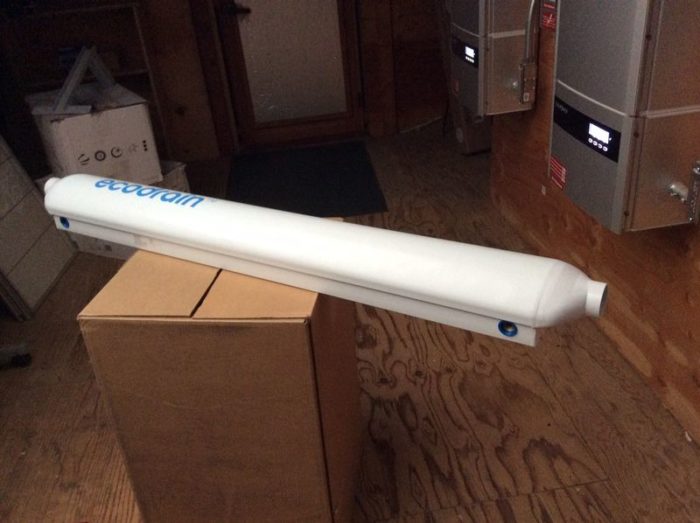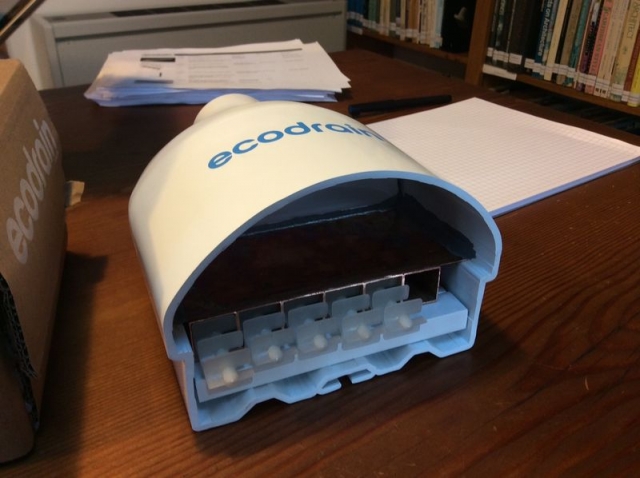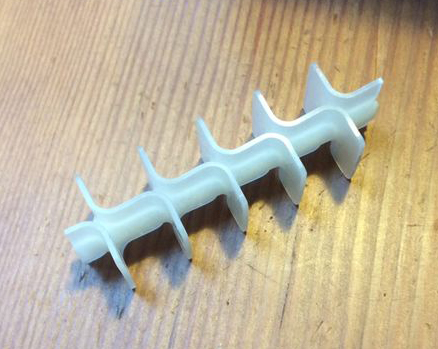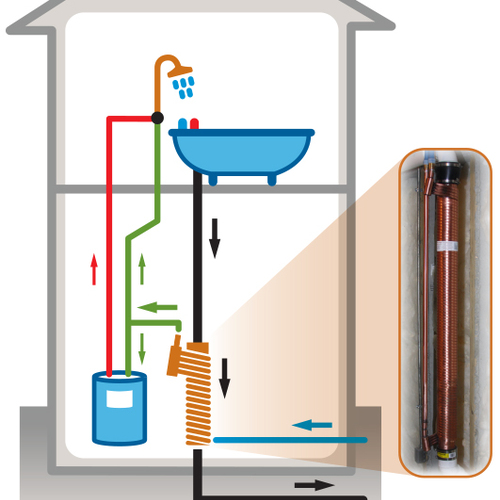
Image Credit: All photos: Marc Rosenbaum
The EcoDrain is a wastewater heat recovery device that replaces a section of horizontal drain pipe. The devices enables heat from water flowing down the drain to be transferred to cold water flowing toward a shower valve.
David Velan of EcoDrain paid us a visit here at South Mountain so my colleague Brice Delhougne and I could see his product firsthand. A few years ago David got interested in capturing the waste heat in shower water and other hot waste water. Others have done that (PowerPipe) but they have been limited to applications where the vertical heat exchanger, usually 4 to 6 feet long, can fit, and still be higher than the wastewater outlet from the building.
EcoDrain’s innovation is a wastewater heat exchanger that can be mounted horizontally.
In the photo above, you can see the inlet and outlet, which are 2-inch-diameter PVC, and the side taps for the inlet and outlet for the potable water. The unit is about 56 inches long. The flow is countercurrent: the wastewater on top flows one way, and the potable water below flows in the opposite direction and picks up heat across the copper interface. Depending on the relative flow rates, and the pitch of the unit, the EcoDrain recovers 30-45% of the energy in the wastewater.
David went through many evolutions before arriving at his product. It has a double-wall heat exchanger configuration that should satisfy codes (the product has a UPC acceptance) and square section tubes on the potable water side to maximize heat exchange contact area. The upper portion of the unit is PVC and is smooth to minimize any buildup of solids.
The photo at left shows a cross section.
One of the EcoDrain innovations is seen in each square tube: a plastic insert designed to keep the flow highly turbulent to increase heat transfer.
The bottom of the unit has a drain hole so that any leaks become obvious quickly.
The unit is designed to work with very slight pitch, like a typical plumbing waste line, but it can be pitched at more severe slopes, and the increased velocity of the wastewater increases heat recovery.
The unit can be plumbed so that the preheated water flows to the cold side of the shower, or to both the shower and the cold inlet of the water heater. The latter equal flow configuration will harvest the most BTUs.
Let’s do some Marc’s Sloppy Math. Say a family uses 30 gallons/day of shower water and 1/3 of that energy is recovered. That’s about 625 kWh/year. At $0.20/kWh (Massachusetts residents are about to see a 30-35% rise in the supply portion of their electric bills due to last winter’s natural gas price squeeze!), that’s $125 per year. The unit costs $440, and let’s say it ends up at an installed cost of $1,000. There’s a simple 8 year payback. With natural gas this will be worse.
To get 625 kWh/year from PV would take about 500 watts of panel, which costs more than the EcoDrain installed.
One application David related to me is using the EcoDrain in cases where people are running out of hot water. Recovering drainwater heat effectively stretches the storage capacity of a water heater.
David kindly left us with one and we’re looking for a good application, so we can monitor its performance in an actual situation. We were impressed with the iterative thoughtful engineering embodied in the product, its rugged construction, the testing EcoDrain has done to show energy recovered, and its clog-free performance.
Marc Rosenbaum is director of engineering at South Mountain Company on the island of Martha’s Vineyard in Massachusetts. He writes a blog called Thriving on Low Carbon. Marc teaches a 10-week online Zero Net Energy Home Design course as part of NESEA’s Building Energy Master Series. You can test drive his class for free.
Weekly Newsletter
Get building science and energy efficiency advice, plus special offers, in your inbox.

















14 Comments
No NRCAN test data listing yet?
Natural Resources Canada maintains lists of the efficiency of drainwater heat recovery units when performed by third party test houses under a standardized set of conditions, so that one can compare apples-to-apples. There are very few horizontal mount units out there competing, but I'd think it worthwhile to actually test the EcoDrain to the NRCAN standard to get a better handle on it.
http://oee.nrcan.gc.ca/pml-lmp/index.cfm?language_langue=en&action=app.search-recherche&appliance=DWHR&attr=0
http://www.nrcan.gc.ca/energy/efficiency/housing/home-improvements/12356
"Depending on the relative flow rates, and the pitch of the unit, the EcoDrain recovers 30-45% of the energy in the wastewater."
Unlike the gravity-film vertical types, at very low flows the recovery efficiency of the EcoDrain may go down at some low-flow point, since unlike the gravity film units it relies upon turbulence for heat exchange efficiency. I've watched this company since pretty near their beginnings (with an all-stainless steel design), but have yet so see much in the way of performance data, and it would be important to know where the inflection points are in the curves relative to flow & pitch. A 30-45% difference in recovery efficiency is a significant range- if there are good / better / best flow rates & angles, shouldn't that be published? (I think most of us would prefer to set up up for 45% efficiency rather than 30%.) On page 3 of the installation manual it states:
"Note that heat transfer performance will increase as the tilt angle
increases. This can boost heat exchanger performance by 5%-10%. The
reason is that at a higher tilt angle, the waste water travels faster.
This generates turbulence in the waste water flow and as a result the
waste water gives off heat at a higher rate. With the A1000 unit, a
maximum slope of 75o is recommended to allow an efficient heat transfert. " (sic)
( https://ecodrain.ca/media/products/ecodrain-installation-manual.pdf )
A 75 degree tilt is significant- if that's what it takes to hit 45% efficiency there will be many installations that will have to settle for less, but it would be good to know how much you're giving up with every 5 degrees of tilt lower than that very crooked nearly vertical angle, and how much is given up by going with unbalanced flow (option A, on p.1 ) vs. balanced flow (option B).
In MA the EcoDrain does not appear under the state's "Accepted Plumbing Fixtures" list (yet), which means it would require a variance to install in that state. http://license.reg.state.ma.us/pubLic/pl_products/pb_product.asp ( But there are two gravity-film type drainwater heat exchanger companies with products listed, Renewability 's "PowerPipe" series, and EcoInnovation's "ThermoDrain" series.)
It would be an easier sell with more data and fewer code-hoops to jump through. For homes with shallow crawl-space or slab on grade foundations it would be about the only option going.
It's true that drainwater heat exchangers increase the "apparent size" of tank type hot water heaters in terms of showering capacity, and increase the "apparent efficeincy" of all types of water heaters. When looking at capacity issues with better-class stainless steel heat pump water heaters, the drainwater heat recovery may be comparable or even lower cost than upsizing the water heater just to cover more showering capacity.
BTW: The statement "Massachusetts residents are about to see a 30-35% rise in the supply portion of their electric bills due to last winter's natural gas price squeeze!" is a gross underestimate of the actual supply charge increases, and is closer to the boost for the whole bill (transmission & fixed charges included.) For National Grid customers the supply went from about 8 cent to 16 cents, which is a 100% increase, and for NStar customers it is going from about 9 cents to about 15 cents, more than 60% increase, while the transmission charges remain about the same. Those two utilities combined cover something like half the residential electric ratepayers in the state, so even if NO other utilities got a price bump (not likely) it would already be more than a 30% increase on a statewide average.
And...
...at 15-16 cents/kwh the standard supplier rate is now higher than many all-renewable supplier options. In MA (as in other "decoupled" states) one is allowed to purchase power from someone other than the local grid-utilities' standard mix. At these prices even UNSUBSIDIZED rooftop solar is cheaper, when net-metered (which offsets the transmission charges as well as the supply.) If there was ever a really good time to pull the trigger on a rooftop PV system deal in MA (whether leased or purchased) , this might be one of those times.
DWHR ROI depends n input costs and use patterns
Input cost: fluctuating market rates for energy
Input value: volume of DHW passing through the system (i.e. size of house hold, length of shower)
EcoDrain was evaluated in Canada.
"DWHR is much more economical for households with electric hot water heaters as their energy costs are much higher. A household of 4 or more people with an electric hot water heater would benefit from installing a DWHR device such as the EcoDrain. Locations with natural gas heaters would benefit from DWHR if there are more than 14 users a day, or if natural gas prices return to more historic levels."
"Based on the configuration of the analysis, the average Canadian household would
not see a benefit from installing this DWHR device. Generally speaking, the current low costs of natural gas make the economics of using a DWHR device in a household with a natural gas water heater difficult. If natural gas prices return to more historical rates, this could change. The break-even analysis revealed that a household size of 4 or more with an electric hot water heater would benefit from installing a DWHR device."
https://circle.ubc.ca/bitstream/handle/2429/46650/Frankowski%20_C_SEEDS_2013.pdf?sequence=1
http://www.cmhc.ca/odpub/pdf/65680.pdf
http://www.nrcan.gc.ca/energy/efficiency/housing/home-improvements/12356
http://sbrn.solarbuildings.ca/c/sbn/file_db/Doc_File_e/On%20the%20combined%20effect%20of%20wastewater%20heat.pdf
Don't discount the smaller HW equipment savings.
Running the numbers purely on the energy cost savings may make sense in a retrofit scenario, but ignores potential offsetting of cost on the size/capacity of the hot water heating mechanicals, which is often significant.
In my own home the custom combi-system does not have sufficient capacity to run a 24/7 shower, let alone heat the house while doing so. But with a ~50% efficient gravity film type drainwater heat exchanger it manages both. That reduced the size of the indirect HW heater necessary &/or reduced the storage temp requirements, which allows the gas fired system to run at condensing temps 100% of the time.
On purely gas-use savings basis the "payoff" of my DWHX would be more than a decade, but in fact the thing paid for itself up front in smaller/cheaper equipment for the rest of the system. Clearly YMMV, but know that it can be more about far more than mere net-present-value of future fuel savings, if done with some forethought.
usability issue
The suggestion to plumb the potable output of this device to the shower cold water make intuitive sense: it's a short run, and by warming the cold water you can change the ratio to save hot water.
The downside I see is that, if this system takes time reach steady state (as it must), the target hot/cold ratio is going to keep shifting as the incoming cold water is increasingly warmed by the wastewater.
In general, people do not want their shower temperature to change on them. Many people waste a ton of water, or spend money to install recirculation pumps, so that they can set their shower temperature and not worry about it. This device seems likely to take an existing problem and make it much worse (and recirc pumps won't help!).
I hope that the people who install this device will not then run additional water to avoid the shifting temperature problem, but I wouldn't count on it. In any case, the homeowner is faced with spending money in order to save energy but at the price of ongoing inconvenience. That doesn't sound like a recipe for market success.
Perhaps I am over-estimating the severity of this issue, but I doubt it. The heat exchanger has some thermal mass, and that's going to cause a time lag in temperature rise.
I would be interested to know if the mfg has a response or a solution.
Brent ... We use a
Brent ... We use a thermostatic mixing valve to regulate DHW supply temp to the shower. A DWHR routed back to the shower should be upstream of that valve. But routing to the (preheating) supply seems to have better payback (if I read the articles correctly and is Dana point, too).
Dana, considering fully loaded and opportunity costs was missing from the articles and evaluations. As usual, your foresight adds pain to my hindsight.
But in our case with two occupants and a Prestige Excellent, DWHR would be little benefit. If I added a preheating tank we might get some value if its well insulated and we bring all drains into the unit (particularly the cloths washer).
We have installed kick control valves at the DHW taps in all sinks so the HW is used only when held on by holding the lever situated at the toe kick.
http://www2.buildinggreen.com/blogs/foot-control-faucet-convenience-and-savings
http://www.finehomebuilding.com/departments/feedback/foot-pedal-powered-faucet.aspx
Hot water lag time
I was @ a home show couple years back and there was a device that keep hot water @ the facet so we didn't waste alot of water waiting for it to get hot. Anyone know what that is?
Response to Terry Lee
Terry,
Probably the D'Mand pump.
Here are some links:
http://www.finehomebuilding.com/design/departments/energy-smart-details/hot-water-circulation-loops.aspx
https://www.greenbuildingadvisor.com/product-guide/prod/taco-hot-water-dmand-system
https://www.greenbuildingadvisor.com/blogs/dept/energy-solutions/waiting-hot-water
https://www.greenbuildingadvisor.com/green-basics/hot-water-circulation
Response to Marc -- Still looking for test subject?
Hi Marc -
We have just started construction on our DER / LEED-H renovation, and I think we're perfect test subjects! (That is, IF you're still "looking for a good application".) Just let me know!
Thanks as always for the informative post,
Erica Downs
My two cents
Thanks for the article and discussion - have had my eye on this product recently...@flitch plate, my understanding is that the most efficient configuration is to plumb the cold pipes coming out of the unit to both the shower cold side and the DWH: greater total cold water flow through the unit extracts the most BTU's.
Any comments on plumbing to other than showers? I think grease issues (k. sink) and uneven flow (dishwasher or washing machine) would argue against.
Almost everything about DWHR efficiency (for David Gregory)
Can be gleaned from the testing done by the good folks at Natural Resources Canada:
http://www.regie-energie.qc.ca/audiences/3637-07_2/DDR3637_2/RepDDR/B-12-GI-23Doc1-2_RepDDRSE-AQLPA_3637-2_28sept07.pdf
The horizontal EcoDrain is a different beast though, and will have very different operating characteristics. Whereas gravity film heat exchangers hit highest performance at the lowest flow rates (due to thinner water films clinging to the interior side of the drain) heat exchange on the EcoDrain rely heavily on turbulence on the drain side of the heat exchanger, and slower rates would deliver less turbulence and less heat exchange due to laminar flows.
The "balanced flow" issue where higher efficiency is attained when all water going down the drain had passed through the potable side of the heat exchanger on the way in (both the hot and the cold side feed to the shower) would be roughly the same, independent of heat exchanger type.
lifetime separation of
lifetime separation of waters?
It looks from pics to be made of pieces... will it fail someday? Will some fail during manufacture?
Differential expansion .... PVC verses copper.... etc... glued joints? gaskets? no joints?
Martin.... make a phone call?
Dana
thanks for the nice link, i had looked for this study but never found it a few years back !
I am amazed on how much one can save by using such a device....
even with a 2-3 COP water heater, this would have a good hot long shower usring family in ROI of ~ 10 years.
I thought it was less efficient than that originally.
as for the ecodrain
i feel the same as AJ about longevity and security ..
unless we can get very high efficiency results ..which i doubt it will surpass the 30-50%efficiency
from the vertical tested units ...
Out of curiosity,
how many % do you guys believe that recent/new efficient builds/green houses
Laminar vs turbulent flow
I'm not sure that the flow on the drain side of the Ecodrain transitions from laminar to turbulent as it is tilted - maybe that happens. My understanding is that the increase in heat recovery efficiency is with the plastic inserts on the potable side of the heat exchanger that keep the potable side both turbulent and maintaining an impinging contact with the heat exchange surface.
Log in or create an account to post a comment.
Sign up Log in